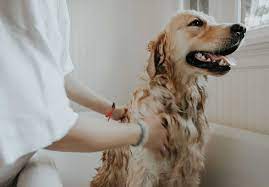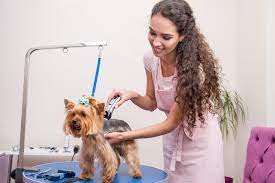Certainly! Let's embark on an extensive exploration of the captivating world of pet grooming, diving into the various dimensions, techniques, and nuances within this field:
1. Foundations of Pet Grooming
Hygiene and Health: Unveiling the vital role grooming plays in maintaining a pet's hygiene, skin health, and overall well-being.
Establishing Routine: Educating pet owners on the importance of regular grooming sessions to prevent matting, skin infections, and addressing any underlying health concerns.

2. Pet-Specific Grooming Techniques
Dog Grooming: Delving into diverse dog breeds and their specific grooming needs—long-haired, short-haired, curly-coated—covering brushing, bathing, and trimming techniques.
Cat Grooming: Navigating the unique challenges of grooming cats—managing stress, handling sensitive areas like ears and paws, and the significance of cat-specific grooming tools.
3. Tools and Equipment
Essential Tools: Detailing the array of grooming tools—brushes, combs, clippers, scissors, and specialized grooming equipment—emphasizing their role in efficient grooming practices.
Tool Maintenance: Educating on the care and maintenance of grooming tools, ensuring longevity and hygiene.
4. Bathing and Skincare
Bathing Techniques: Exploring the best practices for bathing pets—choosing appropriate shampoos, water temperature, and the importance of thorough rinsing.
Skin and Coat Care: Addressing skin conditions, allergies, and promoting coat health through proper grooming techniques and appropriate grooming products.
5. Nail and Ear Care
Nail Trimming: Techniques for safe and stress-free nail trimming, understanding the anatomy of pet nails, and managing overgrown nails.
Ear Hygiene: Steps to maintain clean ears, techniques for cleaning ears, and recognizing signs of ear infections or discomfort.
6. Brushing and Coat Maintenance
Brushing Routines: Tailoring brushing routines based on coat types—long-haired, short-haired, double-coated breeds—preventing mats, tangles, and shedding.
Dealing with Shedding: Tips for managing shedding, utilizing proper brushing techniques, and selecting appropriate shedding tools.
7. Specialized Grooming for Different Breeds
Breed-Specific Styles: Unveiling breed-specific grooming standards for dogs, understanding the intricate cuts, trims, and styles that highlight breed characteristics.
Show Grooming: Exploring grooming techniques and standards for show dogs, emphasizing the precision and artistry in showcasing a dog's breed standard.
8. Creative Grooming and Styling Trends
Artistic Grooming: Showcasing the artistry and creativity in grooming—coloring, creative designs, and innovative styles that add flair to pet appearances.
Trending Styles: Exploring contemporary grooming trends, from classic cuts to avant-garde styles, and the influence of social media on grooming trends.
9. Grooming for Special Needs and Seniors
Senior Pet Care: Adapting grooming routines for senior pets, addressing mobility issues, coat changes, and offering gentle grooming practices for older pets.
Special Needs Pets: Strategies for grooming pets with special needs—sensory issues, anxiety, disabilities—creating a calm and supportive grooming environment.
10. Handling and Behavior Management
Stress-Free Grooming: Techniques for reducing grooming-related stress in pets—positive reinforcement, desensitization, and creating a calm grooming environment.
Understanding Pet Behavior: Recognizing body language, stress signals, and adapting grooming practices to suit individual pet personalities.
11. Professional Grooming Services
Role of Grooming Professionals: Highlighting the expertise and skills of professional groomers, their training, certifications, and the importance of accredited grooming salons.
Choosing Grooming Services: Tips for pet owners on selecting reputable groomers, assessing grooming facilities, and communicating grooming expectations.
12. Grooming Emergencies and First Aid
Handling Accidents: Preparing for grooming emergencies—cuts, nicks, and accidents—knowing basic first aid, and when to seek veterinary assistance.
Safety Protocols: Ensuring grooming safety for pets—proper restraint, safe handling techniques, and emergency protocols in grooming settings.
13. Grooming Education and Career Paths
Grooming Education: Exploring grooming courses, certifications, and educational pathways for aspiring groomers, emphasizing continuous learning and skill enhancement.
Career Opportunities: Navigating career prospects in the grooming industry—working at salons, mobile grooming, entrepreneurship, and specialized grooming niches.
14. Ethics and Advocacy in Grooming
Ethical Grooming Practices: Advocating for ethical grooming—respecting pet welfare, avoiding unnecessary procedures, and transparency in grooming practices.
Animal Advocacy: Supporting initiatives promoting ethical grooming standards, awareness campaigns, and advocating for pet welfare in grooming practices.
15. Technology and Innovations in Grooming
Grooming Tech Advancements: Exploring technological innovations—smart grooming tools, grooming apps, and advancements in grooming equipment enhancing efficiency and precision.
Digital Platforms: Leveraging digital platforms for grooming education, online grooming consultations, and virtual grooming communities.
16. Cultural and Regional Grooming Practices
Cultural Variances: Exploring cultural influences on grooming practices—regional grooming traditions, diverse grooming rituals, and their significance.
Regional Grooming Challenges: Addressing challenges in grooming practices specific to certain regions—climate impact, cultural preferences, and regional pet care norms.
17. Pet Grooming as a Bonding Experience
Building Trust: Emphasizing grooming as a bonding experience between pets and owners—fostering trust, communication, and strengthening the human-pet relationship.
Family Involvement: Involving families in grooming routines, encouraging participation, and creating shared experiences in pet care.
18. Promoting Pet Well-being Through Grooming
Holistic Well-being: Recognizing grooming as a holistic practice—physical, mental, and emotional well-being of pets—and its contribution to a pet's overall quality of life.
Preventive Health Measures: Emphasizing the role of grooming in early detection of health issues, promoting preventive care, and contributing to a pet's longevity.
19. Consumer Awareness and Grooming Standards
Consumer Education: Advocating for pet owner education—understanding grooming practices, recognizing quality grooming services, and consumer rights.
Industry Standards: Exploring grooming industry standards, certifications, and the importance of adhering to ethical and safety protocols.
20. Continued Evolution and Future Trends in Grooming
Trends and Innovations: Predicting future trends—emerging grooming styles, technological advancements, and the evolving role of grooming in pet care.
Adapting to Change: Encouraging adaptability, continuous learning, and embracing innovations to stay abreast of evolving grooming practices.
"Pampered Paws" embodies the convergence of expertise, creativity, and care



You must be logged in to post a comment.